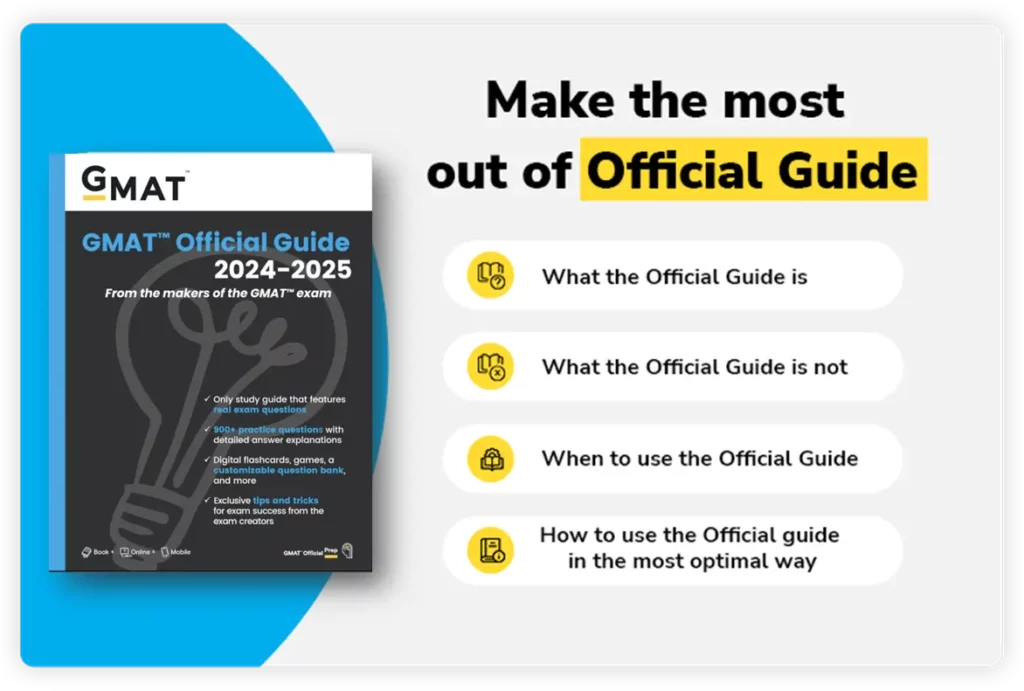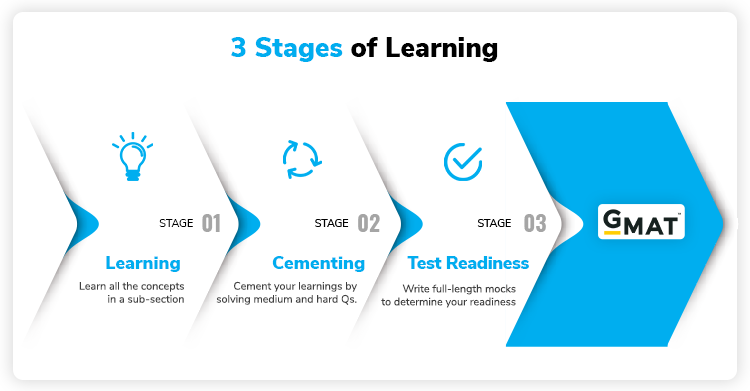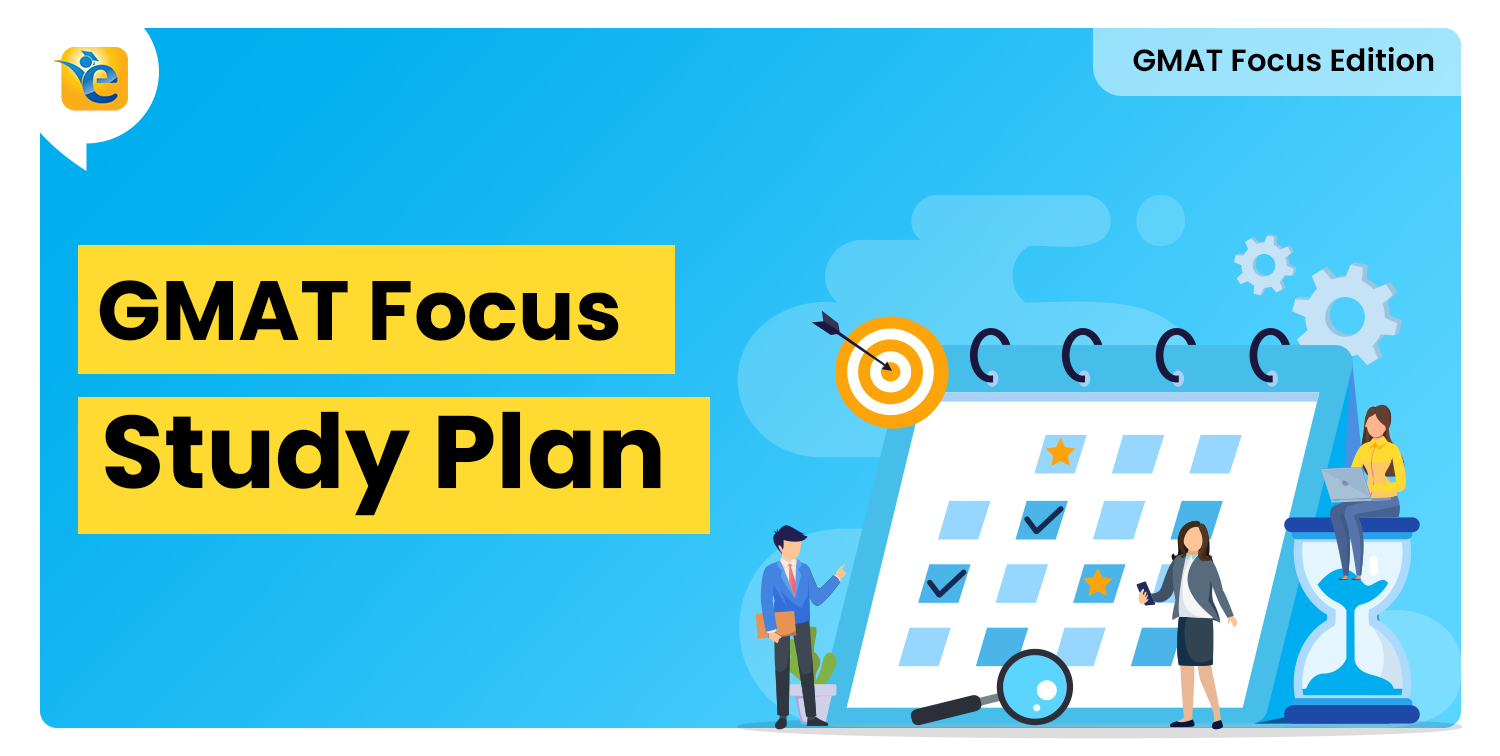The GMAT Official Guide (OG), published by the Graduate Management Admission Council (GMAC), is widely considered an essential resource for exam preparation. The 2024-2025 edition continues this tradition with hundreds of authentic questions from previous exams. Yet many test-takers misunderstand its purpose, attempting to use it as a comprehensive learning tool rather than recognizing its primary value as a practice resource. This distinction raises critical questions for anyone preparing for the GMAT:
- Is studying the GMAT Official Guide alone sufficient to achieve your target score?
- Does it adequately cover all concepts tested on the exam?
- What are the best practices for integrating GMAT Official Guide questions into your preparation strategy?
In this guide, we’ll address these questions and provide a framework for transforming the GMAT Official Guide from a simple question collection into a strategic component of your GMAT success.

You will find answers to all these questions here.
Broadly speaking, here is what this article will cover:
- What the Official Guide actually is – a comprehensive look
- What the GMAT Official Guide Is Not
- WHY THE GMAT OFFICIAL GUIDE MAY BE INSUFFICIENT
- THE THREE-STAGE APPROACH TO USING THE GMAT OFFICIAL GUIDE
- STRUCTURED CEMENTING PLAN USING THE GMAT OFFICIAL GUIDE
- TEST READINESS WITH THE GMAT OFFICIAL GUIDE
- GMAT Official Guide 2024-2025: Should You Buy It?
- Conclusion
What the Official Guide actually is – a comprehensive look
Now, let’s understand what exactly the GMAT Official Guide is at a deeper level.
GMAT Official Guide: A Collection of Excellent Questions
First and foremost, the GMAT Official Guide is a question bank—the largest collection of high-quality questions you’ll likely encounter in your GMAT preparation journey.
The GMAT Official Guide 2024-2025 contains 790 authentic practice questions covering all sections of the current GMAT Exam:
- 271 Quantitative Reasoning questions
- 335 Verbal Reasoning questions (including Critical Reasoning and Reading Comprehension)
- 184 Data Insights questions
These questions span the full range of topics tested on the GMAT and are organized in increasing order of difficulty (Easy → Medium → Hard). They are authentic GMAT questions created by the test makers themselves, reflecting the exact style, format, and thinking processes you’ll encounter on test day. Every question has a solution that provides the correct approach and explains why certain answer choices are correct or incorrect. While these explanations are valuable, they tend to be concise rather than comprehensive.
GMAT Official Guide: A Concise Overview of the GMAT Syllabus
The Official Guide provides a brief description of everything tested on the exam:
- Topic indices for each section, making it easy to locate questions related to specific concepts
- Review chapters for each section that provide foundational concepts and explanations of question types
- Test-taking strategies for approaching different question types and managing time effectively
While the OG ensures you have visibility into all topics and question types you’ll encounter, it doesn’t teach these concepts in depth.
What the GMAT Official Guide Is Not
Understanding what the GMAT Official Guide is not is as important as knowing what it is. The GMAT Official Guide itself states:
The GMAT™ Official Guide series is the largest official source of actual GMAT™ questions. You can use this series of books and the included question bank to practice answering the different types of questions.
Section 2.3, GMAT OG 2024-2025
(How to use the GMAT™ Official Guide)
The operative word here is “practice”—not “learn.”
The GMAT is fundamentally a test of application. Success requires both conceptual knowledge and the ability to apply certain skills in a logical manner. While the OG provides excellent practice questions, it does NOT:
- Provide in-depth concept explanations
- Teach systematic processes for approaching different question types
- Focus on building foundational skills
- Offer personalized guidance for improvement
For most test-takers, particularly those not starting at advanced levels, the OG works best as a practice tool after you’ve built your conceptual foundation elsewhere.
WHY THE GMAT OFFICIAL GUIDE MAY BE INSUFFICIENT
For test-takers beginning with lower abilities, the Official Guide presents two fundamental challenges:
Limited Question Quantity for Learning Purposes
In specific question types (e.g., Critical Reasoning Assumption questions), you may find only 15-20 questions in the entire guide. In our experience at e-GMAT, most learners with lower starting abilities typically need:
- 20-30 questions of increasing complexity to learn any specific question type
- Additional questions to practice and reinforce those skills
- Further questions for final reinforcement before the exam
If you use the limited OG questions for learning, you’ll have few or no fresh questions left for actual practice.
Your Starting Ability Matters
Your starting ability level significantly impacts how effectively you can use the Official Guide:
- High starting ability (80th percentile+): The OG may be sufficient as you primarily need authentic practice
- Medium ability (60th-79th percentile): You’ll need more comprehensive explanations to refine your approaches
- Lower ability (below 60th percentile): You need both more questions for learning and more detailed explanations
THE THREE-STAGE APPROACH TO USING THE GMAT OFFICIAL GUIDE
For optimal results, we recommend following a three-stage approach to GMAT preparation:
Stage 1: Learning
In this initial stage, focus on building your conceptual foundation and developing systematic approaches to each question type:
- Study core concepts and frameworks
- Learn step-by-step methodologies for approaching different question types
- Practice with simpler questions that reinforce basic principles
- Reserve your Official Guide questions for later stages
Stage 2: Cementing
Once you’ve established a solid foundation, move to cementing your knowledge:
- Work through medium and hard-level practice questions across all subsections
- Complete several sets of quizzes for each subsection to internalize skills and processes
- Focus on one section or question type at a time
- Review each question thoroughly, regardless of whether you got it right or wrong
- Use an error log to track your progress and identify weak areas
- Begin incorporating Official Guide questions after you’ve internalized your learning through these quizzes
Stage 3: Test Readiness
In this final stage, focus on getting fully prepared for exam conditions:
- Practice handling questions from multiple subsections simultaneously
- Build stamina for the full exam duration through longer practice sessions
- Assess your current ability through timed practice tests
- Fine-tune your approach through targeted practice based on your Error Log
- Use Official Guide questions to simulate authentic test conditions

STRUCTURED CEMENTING PLAN USING THE GMAT OFFICIAL GUIDE
After building your foundation in Stage 1, here’s how to effectively incorporate the Official Guide into your Cementing stage:
- Start with medium-difficulty questions for each section (skip easy questions if you’re already at 60th percentile ability)
- Create topic-focused quizzes of 15 questions each from the Official Guide
- Time your quizzes according to these guidelines:
- Verbal Reasoning: 1.96 minutes per question (45 minutes for 23 questions)
- Quantitative Reasoning: 2.14 minutes per question (45 minutes for 21 questions)
- Data Insights: 2.25 minutes per question (45 minutes for 20 questions)
- Transition methodically to harder questions:
- Take a transition quiz mixing medium and hard questions
- Aim for 85%+ accuracy before moving to exclusively hard questions
- If you score below 85%, review, learn, and repeat the transition quiz
- Validate your ability with multiple quizzes:
- Complete at least 2 quizzes at both medium and hard levels
- For hard quizzes, aim for at least 60% accuracy (minimum threshold)
- Target 70% accuracy for 85th percentile ability
- Target 75% accuracy for 90th percentile ability
- Review thoroughly after each quiz:
- Don’t rush from one quiz to the next
- Maintain a detailed Error Log with question type, mistake pattern, and correct approach
TEST READINESS WITH THE GMAT OFFICIAL GUIDE
The Test Readiness stage is where your preparation culminates. Here’s how to effectively use the Official Guide during this critical phase:
Progressive Test Readiness Plan
- Start with multi-section quizzes
- Create mixed quizzes that include questions from different sections
- Gradually increase quiz length to build stamina
- Use the remaining Official Guide questions for these comprehensive quizzes
- Move to full practice tests
- Take full-length practice tests that simulate exam conditions
- Space tests 3-4 days apart (never on consecutive days)
- Schedule your exam once you consistently achieve your target score in at least 2 consecutive tests
- Implement targeted refinement between tests
- Review each practice test thoroughly
- Use your Error Log to identify specific weaknesses
- Address these weaknesses before taking the next test
Targeted Refinement Process
When your Error Log reveals a specific weakness, follow this process:
- Revisit concepts relevant to your weak area
- Practice without time pressure, focusing on perfecting your approach
- Build speed under test conditions with timed practice
- Validate improvement with a small quiz of fresh Official Guide questions
Save 20-30% of Official Guide questions from each section specifically for this Test Readiness stage, prioritizing your weaker areas.
GMAT Official Guide 2024-2025: Should You Buy It?
The GMAT Official Guide 2024-2025 continues to serve as a valuable resource aligned with the current GMAT Exam format, offering authentic practice questions across all sections: Quantitative Reasoning, Verbal Reasoning, and Data Insights. The guide provides comprehensive coverage of the skills and question types you’ll encounter on test day, making it a worthwhile investment for most GMAT aspirants.
For First-Time GMAT Official Guide Buyers
If you don’t own any previous edition, the GMAT Official Guide 2024-2025 is absolutely worth purchasing. It provides:
- Access to 790 authentic GMAT questions with detailed explanations
- Comprehensive coverage of the current exam format and content
- Insights into question patterns directly from the test makers
- Essential strategies and approaches for each section
As a primary resource directly from GMAC, it offers unparalleled authenticity in practice materials.
For Owners of the 2023-2024 Edition
If you already own the GMAT Official Guide 2023-2024, the decision requires more consideration. The 2024-2025 edition offers:
- 43 new Quantitative Reasoning questions
- 27 new Data Insights questions
- No significant changes to the Verbal Reasoning section
This means you would be investing in access to approximately 70 new questions, which represents less than 10% new content compared to the previous edition. While these new questions do provide additional practice material, you should weigh whether this limited amount of new content justifies the purchase price.
For most previous edition owners, we recommend focusing your investment on quality supplementary materials that address the Official Guide’s limitations rather than spending on a handful of new questions. However, if comprehensive access to official questions is a priority in your preparation strategy, the 2024-2025 edition may still be worth adding to your resource library.
Conclusion
The GMAT Official Guide 2024-2025 is an invaluable practice resource with 790 authentic questions directly from the test makers. When used strategically within our recommended three-stage approach—Learning, Cementing, and Test Readiness—it becomes a powerful tool for achieving your target score. Remember that the Official Guide’s strength lies in practice, not initial learning. Build your foundational skills first, then leverage these official questions at the right time to refine your abilities and confirm your readiness. With this thoughtful approach to preparation, you’ll maximize the Official Guide’s value and position yourself for success on test day.















